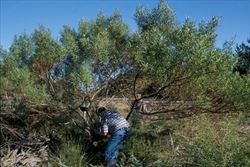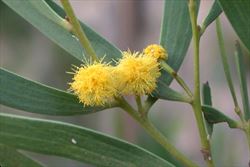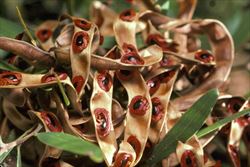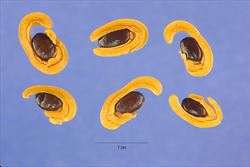Click on images to enlarge

habit (Photo: Bruce Maslin)

habit (Photo: Bruce Maslin)

close-up of small globular flower clusters (Photo: Rob and Fiona Richardson)

close-up of mature fruit with distinctive seeds surrounded by large red arils (Photo: Bruce Maslin)

close-up of old seeds with faded arils (Photo: Steve Hurst at USDA PLANTS Database)
Scientific Name
Acacia cyclops A. Cunn. ex G. Don
Synonyms
Acacia cyclopis A.H. Mackay ex LoudonAcacia cyclopis F. Muell.Acacia cyclopis SweetAcacia eglandulosa DC.Acacia mirbeli Dehnh., ortho. var.Acacia mirbelii Dehnh.Racosperma eglandulosum (DC.) Pedley
Family
Fabaceae: sub-family Mimosoideae (New South Wales)Leguminosae (South Australia)Mimosaceae (Queensland, the ACT, Victoria, Tasmania, Western Australia and the Northern Territory)
Common Names
coastal wattle, cyclops acacia, cyclops wattle, one-eyed wattle, red eye, red-eye, red-eyed wattle, redwreath acacia, rooikrans, rooikrans acacia, western coastal wattle
Origin
Native to the coastal districts of southern Western Australia and southern South Australia. It is widespread in coastal and near-coastal areas between Leeman on the western coast of Western Australia east to the Yorke Peninsula in South Australia.
Cultivation
In Australia, western coastal wattle (Acacia cyclops ) has been widely grown as a garden ornamental in the southern parts of the country. It has been employed as a stabiliser of coastal sand dunes, and has also been put to this use in many other countries (particularly in northern and southern Africa). It is also grown overseas for its dense and high quality fuelwood.
Naturalised Distribution
Western coastal wattle (Acacia cyclops) is naturalised in some parts of south-eastern South Australia (e.g. in the Flinders Ranges and the Southern and Northern Mount Lofty Ranges regions). It may also be naturalised beyond its native range in other areas, such as on the Eyre Peninsula, the Yorke Peninsula, and on parts of Kangaroo Island. It is also naturalised in some parts of southern Victoria.
Western coastal wattle (Acacia cyclops) has also become naturalised in other parts of the world (i.e. in Europe, southern Africa, and California in south-western USA), and is particularly widespread in South Africa.
Habitat
In its native environment this species grows mainly in coastal heath or dry scrubland communities, on sandy or loamy soils, in temperate regions. It has invaded these same habitats in other parts of Australia, and has also become a concern in the semi-arid inland regions of south-eastern South Australia.
In South Africa it is also found along roadsides and waterways, while in California (USA) it has been reported to invade riparian and wetland habitats.
Habit
A shrub or small tree usually growing 1-4 m tall, but occasionally reaching up to 7 m in height. It usually has a shorter more spreading habit when growing on coastal dunes, and a taller more upright habit when growing in inland areas.
Distinguishing Features
- a large shrub or small tree with alternately arranged simple 'leaves'.
- its relatively thick and leathery 'leaves' usually do not have any glands on them.
- its yellow to golden-yellow flowers borne in small globular clusters that are usually arranged pairs in the 'leaf' forks.
- its elongated and flattened pods (up to 150 mm long) become twisted and coiled after opening.
- its dark brown or black seeds are encircled by a conspicuous orange to bright red fleshy structure.
Stems and Leaves
Its older stems become rounded and are covered in relatively smooth bark, but its younger stems are somewhat flattened (i.e. compressed). These young stems are green and hairless (i.e. glabrous).
The 'leaves' of this plant are actually flattened and widened leaf stalks (i.e. petioles), and not leaves in the true sense of the word. These modified leaf stalks are called phyllodes, but serve the same purpose as a regular leaf. On very young plants, partially formed phyllodes can be seen which bear twice-compound (i.e. bipinnate) leaves at their tips. As the seedling grows, each new 'leaf' has phyllodes that are more fully formed and the leaves at their tips are eventually reduced to nothing. The bright green phyllodes are alternately arranged along the stems and are relatively thick and leathery (i.e. coriaceous) in nature. They can vary from being relatively long and narrow (i.e. narrowly oblong) to almost oval (i.e. elliptic) in shape. These phyllodes (mostly 4-11 cm long and 4-22 mm wide) are hairless (i.e. glabrous) and either straight or slightly curved. Each phyllode has three or four prominent parallel veins that run down most of its length and where it joins to the stem there is a short thickened structure (i.e. a pulvinus). The tips of the phyllodes are rounded (i.e. obtuse) to pointed (i.e. acute) in nature, but often come to a short and sharp point (i.e. they are apiculate).
Flowers and Fruit
The small yellow or golden-yellow flowers are stalkless (i.e. sessile) and densely arranged into globular clusters (5-7 mm across), each containing numerous (60-75) flowers. The individual flowers each have five relatively inconspicuous petals and sepals and numerous conspicuous stamens that give them a very fluffy appearance. The globular flower clusters are borne on short stalks (i.e. peduncles) 4-12 mm long and emanate from the forks (i.e. axils) of the upper leaves. There are usually two of these flower clusters present in each leaf fork, and they are borne towards the tip of a short branch 3-20 mm long (i.e. in a small axillary raceme with only two flower clusters). Flowering occurs from early spring through to late autumn (i.e. from September to May).
The fruit is an elongated and curved pod (up to 15 cm long and 7-15 mm wide) that is somewhat flattened. It is hairless (i.e. glabrous) and not constricted between the seeds. These pods are green when young but turn brown as they mature, and after opening they become twisted and contorted. Each pod contains several very distinctive hard seeds (5-7 mm long). These seeds are glossy in appearance, smooth in texture, and dark brown to black in colour. They are almost or totally encircled by two folds of a large orange to bright red fleshy structure (i.e. an aril).
Reproduction and Dispersal
Western coastal wattle (Acacia cyclops) reproduces via numerous long-lived seeds. These seeds are mainly dispersed by animals that consume them. Studies have demonstrated that birds, ants and small vertebrates (e.g. rodents) are all heavily involved in the spread of this species. It has also been found that the germination of western coastal wattle (Acacia cyclops) seeds is enhanced by passage through the gut of birds.
Environmental Impact
This species is one of several native acacias which are considered significant environmental weeds outside of their native range within Australia. Western coastal wattle (Acacia cyclops) is regarded as a serious environmental weed in the Mount Lofty Ranges and the Gulf St. Vincent area near Adelaide in south-eastern South Australia. It was introduced to this area through revegetation works and has also escaped garden plantings in this region. It is now a common coastal weed in the saltmarshes, coastal berms and tidal/freshwater wetlands in this region, and readily invades conservation parks and reserves. For example, it is one of several woody weeds infesting the Marino Conservation Park, an area specifically dedicated to the preservation of local biodiversity, situated within the southern suburbs of metropolitan Adelaide. It is fast becoming an out-of-control pest in the Lands End Restoration Area close to Cape Jervis at the bottom tip of the Fleurieu Peninsula. It is also prominent in the Tingira Drive Reserve and is listed as a priority weed species in the Henley South and West Beach Dune Reserve, due to its propensity to form dense thickets that suppress indigenous vegetation through shading and competition for resources.
Western coastal wattle (Acacia cyclops ) is not yet widely naturalised in Victoria, so far having been recorded in a few coastal districts. However, it is seen as a potential threat in this state because of its record of invasiveness and history of significant ecological impacts elsewhere.
This species is particularly troublesome overseas in South Africa, where it is one of the most widespread alien invasive species in the coastal and lowland areas of the Eastern and Western Cape Provinces. Western coastal wattle (Acacia cyclops) was introduced to this country as a dune stabiliser in the 1830's, and by 1975 it had spread to cover over 300,000 hectares of coastal lowlands, and had also moved inland where it formed thickets in sandy river valleys. In this country it typically forms dense thickets, which suppress the indigenous vegetation and reduce species diversity. The impact of this species has been so great, that significant resources have been invested in a biological control campaign to control this species in South Africa.
Legislation
This species is not declared or considered noxious by any state or territory government in Australia.
Similar Species
Western coastal wattle (Acacia cyclops) is relatively similar to several other native wattles, but it is easily differentiated from these otherwise similar species by the large and brightly coloured (i.e. orange or bright red) fleshy aril that surrounds its seeds.
For example, it grows in the same habitats and has a similar habit to coastal wattle (Acacia longifolia subsp. sophorae). However, coastal wattle (Acacia longifolia subsp. sophorae) can be distinguished from this species by its elongated flower clusters (20-50 mm long) as well its smaller cup-shaped aril. Young blackwood (Acacia melanoxylon) trees may also be confused with this species because they have similar arils on their seeds. However, blackwood (Acacia melanoxylon) grows much larger as it matures, has whitish or pale yellow coloured flowers, and though its arils are similar in size they are usually a duller red colour.
Note: For a more in-depth key to distinguish between all of the wattles (Acacia spp.) present in Australia, see the Wattle: Acacias of Australia CD-ROM or Flora of Australia, Volumes 11A and 11B.

